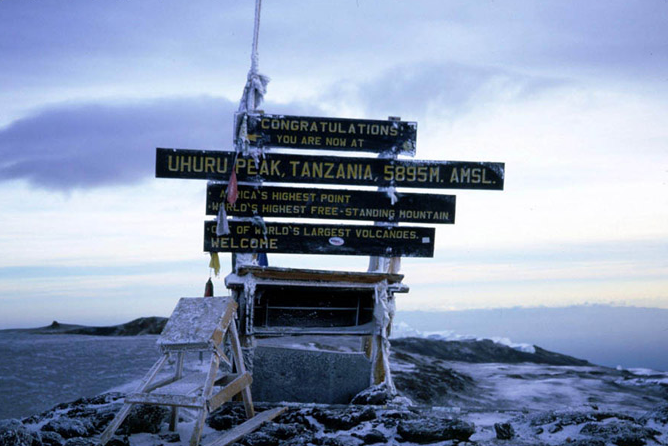 |
| Kilimandjaro by Jeremy V on Flickr (used with permission) |
In preparation for my upcoming "climb" of Kilimanjaro,
I've been reading some literature about the mountain. It seems that most accounts of "climbing" Kilimanjaro involve horribly unprepared and naive hikers. I'm not sure if this is because a story without drama typically isn't a very good story or because stories are typically written by writers, not hikers. Also, with walking being the only physical skill required to reach the summit, I can't imagine Jon Krakauer
* * * * * * *

My Rating: 4.5 out of 5 stars
Buy Zombies on Kilimanjaro: A Father/Son Journey Above the Clouds
* * * * * * *

Interesting Note #1: Crichton mentions using lanterns to provide the light on the pre-sunrise climb to the summit. I realize that there weren't fancy LED headlamps available in 1975, but to the best of my knowledge, regular flashlights already existed. The lanterns made the story feel very dated.
Interesting Note #2: Although the actual summit of Kilimanjaro is Uhuru Peak, Crichton stopped at Gillman's Point at 18,700ft (5700m). Oddly enough, he claims that most hikers stop at this point and consider themselves as having summitted Kilimanjaro, as does he. Maybe things were different in 1975.
My Rating: 3 out of 5 stars
Buy Travels
* * * * * * *
 Up The Mountain Coming Down Slowly is part of How We Are Hungry, a collection of short stories by Dave Eggers. Although it is classified as fiction, Up The Mountain is supposedly based on Eggers' own experience "climbing" Kilimanjaro.
Up The Mountain Coming Down Slowly is part of How We Are Hungry, a collection of short stories by Dave Eggers. Although it is classified as fiction, Up The Mountain is supposedly based on Eggers' own experience "climbing" Kilimanjaro.After her sister Gwen backs out of the Kilimanjaro trip due to getting pregnant, Rita is left contemplating why she's doing this hike and if she's really ready for it. Rita is accompanied by fellow travelers that signed up for the same package tour to Kili's Machame Route. The trek is hampered by bad weather from the beginning and some porters back out before the first day of walking even begins.
Besides Rita's own lack of preparation, it seems that the tour company is also horribly unprepared for the "climb". The mess tent, which doubles as the porters' sleeping quarters, has a hole in it and constantly leaks water when it rains. Also, at one point in the "climb", one of the other group members gives his sunglasses to a porter. This is followed by a lecture by the American trip leader about how they must not give anything directly to the porters. It should first be given to the lead guide, who will then distribute it to the staff member of his choice because there is a pecking order that needs to be followed. It makes me wonder what tour company Eggers used when he "climbed" Kilimanjaro.
Eggers is a literary genius, although sometimes he can be a bit too gimmicky. For instance, the hardcover version of How We Are Hungry includes a story called There Are Some Things He Should Keep To Himself, which consists solely of five blank pages. Thankfully, Up The Mountain refrains from all his gimmicktry. It is a superbly written and haunting portrayal of a Kilimanjaro "climb". The story also brings up some good points about the ethical responsibility of tour companies taking care of not only their paying clients, but also taking care of the porters they use for hauling luggage and supplies up the mountain. This is actually the third time I've read Up The Mountain, so I'd say that it's pretty obvious that I love the story even though it's much darker than most Kilimanjaro stories.
My Rating: 5 out of 5 stars
Buy How We Are Hungry
* * * * * * *

My Rating: 4 out of 5 stars
Buy The Snows of Kilimanjaro and Other Stories
* * * * * * *
Tom Bissell, author of God Lives in St. Petersburg, Chasing the Sea: Lost Among the Ghosts of Empire in Central Asia
My Rating: 4.5 out of 5 stars
* * * * * * *
 |
| Photo courtesy of Canadian Himalayan Expeditions |
About 40,000 people attempt to reach the summit of Kilimanjaro every year. Only 40-50% of them successfully make it to the top. I will become part of those statistics when I attempt to reach Uhuru Peak later this month via the Machame Route (also known as the Whiskey Route).
Have you attempted to "climb" Kilimanjaro, or read any good books, stories, or articles about it? Tell me about it in the comments section below.

No comments:
Post a Comment